Have Your Teen Drive in the Snow
Why practice is crucial for new drivers, even in difficult conditions.
Why practice is crucial for new drivers, even in difficult conditions.

If your teen has never driven in snow, it’s hard to describe the experience.
Snow makes every aspect of driving more difficult, whether you’re speeding up, slowing down or just parking. Experienced drivers have a better understanding of these issues, but many new drivers may not anticipate them at all. When we surveyed dozens of teens recently, only a handful even mentioned weather as a road hazard that concerned them.
Yet, for all its risks, teens need to learn to drive safely in harsh winter weather and the best way to do it is to practice. Here are some tips to make this lesson stick like a tongue to a frozen flagpole.
Before your teen gets behind the wheel, talk through the problems snow, sleet and ice can create for drivers. One small mistake can have major consequences in bad weather, so make sure your teen takes these dangers seriously.
Start with some of the common hazards, like losing traction and visibility, before moving onto the risks created by other drivers. You can also share your own stories of driving in the winter and bring your teen along for rides so he or she can learn from you. Once you’re confident in your teen’s skills, you can hand over the steering wheel for some practice.
Your teen’s first drive in the snow will probably be scary – and that’s okay. When you hit the brakes but the car keeps sliding on ice, it makes you feel powerless. Scary as it is, that feeling is what will really get through to your teen and help him or her understand the risks of winter driving (though it’s also why we recommend having your teen practice in an isolated area).
And while you might be tempted to over-explain some things like how to get out of a skid, be patient. Think of it like parallel parking; your teen will learn much more from trying and failing than from listening to you explain where to move the wheel when. Over time, these skills become instinctual and much more reliable in the moment.
Ultimately, staying safe on winter roads will come down to your teen’s ability to make the right decisions for the conditions. As we said above, snow makes every part of driving more difficult, but it doesn’t make them impossible. What you have to do is help your teen learn to judge the conditions and drive accordingly.
Depending on the situation, this could mean leaving more space between cars, braking earlier than usual or even deciding to stay off the roads entirely. You won’t always be in the vehicle to offer advice so make sure your teen is prepared to make these decisions alone. With enough practice in different scenarios, your new driver will learn to recognize the risks and drive every day like it’s a snow day.
With a century-long legacy, the National Safety Council is a global center for safety expertise. Let's work together to align resources. We look forward to learning about ways we can join efforts to expand safety everywhere!
There are no items in your cart